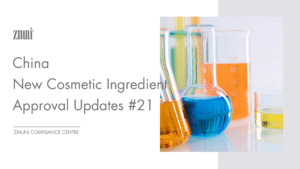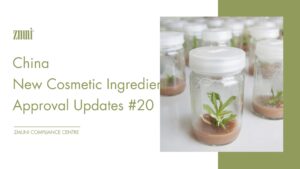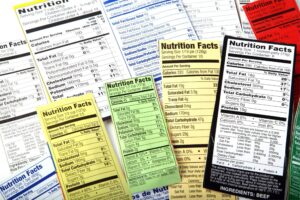+86 571 8659 2517
+86 180 5841 8258
info@zmuni.com

On October 14,2025, China's National Institutes for Food and Drug Control (NIFDC) released 6 draft cosmetic standards for public consultation. These drafts include four test methods and two regulations, with the consultation period open until November 7, 2025. The drafts are as follows: 1. 90-day Oral Toxicity Study 2. 90-day Dermal Toxicity Study 3. Bacterial Reverse Mutation Test 4. In Vitro Mammalian Cells Chromosome Aberration Test 5. General Principles of Cosmetic Product Standards 6. Technical Guidelines on the Intended Use of Cosmetic Ingredients

From October 1 to 15, 2025, 10 new cosmetic ingredients were notified with the China National Medical Products Administration (NMPA). The technical requirements for the 10 new cosmetic ingredients mentioned above have not been disclosed, and they have not yet entered the safety monitoring period. Schizosaccharomyces Pombe Ferment Lysate Filtrate Schizosaccharomyces pombe is one of the commonly used strains in the fermentation industry. It belongs to the group of non-Saccharomyces cerevisiae yeasts, together with Schizosaccharomyces japonicus and Schizosaccharomyces octosporus, forming the genus Schizosaccharomyces. According to the official website of SHE'S YEA, a brand under the notifier Shanghai Yuancui Biotechnology, its Hydrolyzed

On October 14, 2025, the General Administration of Customs of China(GACC) officially issued the Regulations on the Registration and Administration of Overseas Manufacturers of Imported Food (Decree No. 280), which will take effect on June 1, 2026. Upon its implementation, Decree No. 248, released on April 12, 2021, will be repealed. The new regulation was first published as a draft for public consultation on January 3, 2025, together with the Catalogue of Foods Requiring Official Recommendation for Registration (Draft for Comments), which has not yet been released. Below is a brief comparison highlighting the key changes between Decree No. 248 and Decree No.

This article provides a comprehensive overview of key regulatory developments in the food sector in September 2025, both in China and internationally. It focuses on updates related to new food ingredients, food additives, health foods, and feed, aiming to offer timely and in-depth regulatory alerts for enterprises engaged in food import and export. China Food Regulatory Updates 🔘 China Updates on Three New Foods in September 2025 In September 2025, China's National Health Commission (NHC) announced the termination of the review for two new food ingredient applications of D-allulose, and released a public consultation on seven new varieties of food additives, including three

The global cosmetics regulatory environment continues to evolve. To help businesses stay updated with regulatory changes, ZMUni Compliance Center regularly releases a monthly recap of global cosmetics regulations. This article covers the regulatory developments related to cosmetics in China and globally in September 2025, with an emphasis on updates in cosmetic ingredients and cosmetic management, among other areas. China Cosmetic Regulatory Updates New Cosmetics Ingredients (NCI) Notification In September 2025, 11 new cosmetic ingredients were notified with the China National Medical Products Administration (NMPA). They include: Before this recap, ZMUni has continued to release passages introducing the NCI updates,

From September 19 to 29, 2025, 3 new cosmetic ingredients were notified with the China National Medical Products Administration (NMPA). The technical requirements for the 3 new cosmetic ingredients mentioned above have not been disclosed, and they have not yet entered the safety monitoring period. sr-Mussel Polypeptide-4 sr-Mussel Polypeptide-4 comes from the "soft gold of the ocean" — mussel adhesive protein, prized for its remarkable adhesion, repair and biodegradability. It helps soothe and protect the skin. Unlike the traditional method, which requires 10,000 mussels to extract just 1 gram of adhesive protein through a time-consuming process, sr-Mussel Polypeptide-4 is produced using biotechnology. This

On September 16, 2025, China's General Administration of Customs (GACC) released its list of non-compliant imported food products for August 2025. A total of 617 batches from 52 countries and regions were denied entry, representing a month-on-month increase of approximately 30% (up 141 batches from 476 in July) and a year-on-year increase of about 105% (up 316 batches from 301 in August 2024). The majority of non-compliant products originated from Ecuador (18.5%), followed by Japan (8.9%), the U.S. (7.8%), and Italy (6.0%). Key reasons for import rejections included: Non-compliance with national food standards (167 batches) Unqualified labeling (156 batches) Detection of

On September 25, 2025, China's National Health Commission (NHC) released two official Q&A documents on major food labeling standards: GB 28050-2025 National Food Safety Standard - General Rules for Nutrition Labeling of Prepackaged Foods GB 7718-2025 National Food Safety Standard - General Standard for the Labeling of Prepackaged Food Both standards were part of Announcement No. 2 of 2025, issued on March 27, which introduced 50 new national food safety standards and nine amendments. The newly published Q&A clarifies their application and interpretation, helping ensure accurate implementation before they take effect on March 16, 2027. More information: Unpacking China's GB7718
+86 571 8659 2517
+86 180 5841 8258
info@zmuni.com